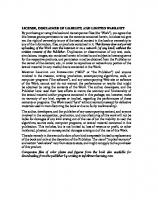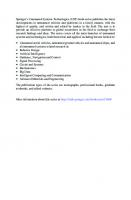Unmanned Air Vehicles: An Illustrated Study of UAVs 0764315005
;Unmanned Air Vehicles: An Illustrated Study of UAVs ВОЕННАЯ ИСТОРИЯ,ТЕХНИКА Название: Unmanned Air Vehicles: An Illustr
361 30 47MB
English Pages 37 Year 2001
0......Page 1
00......Page 2
02......Page 3
04......Page 4
06......Page 5
08......Page 6
10......Page 7
12......Page 8
14......Page 9
16......Page 10
18......Page 11
20......Page 12
22......Page 13
24......Page 14
26......Page 15
28......Page 16
30......Page 17
32......Page 18
34......Page 19
36......Page 20
38......Page 21
40......Page 22
42......Page 23
44......Page 24
46......Page 25
48......Page 26
50......Page 27
52......Page 28
54......Page 29
56......Page 30
58......Page 31
60......Page 32
62......Page 33
64......Page 34
66......Page 35
68......Page 36
999......Page 37
Recommend Papers
File loading please wait...
Citation preview
Unmanned Air Vehicles An Illustrated Study of UAVs
Bill Holder I
Schiffer Military/Aviation History Atglen, PA
Acknolwedgments 1. Kaye LeBeFebure, Scaled Composites 2. Melissa Doboski, Israel Aircraft Industries, Inc. 3. Alan Brown, NASA Dryden Flight Research Center 4. Craig Ballard, Pioneer UAV Inc. 5. David Lanman, AFRUVA, USAF 6. Gary Geiger, Alliant Tech Systems 7. Cynthia Curiel, Northrop Grumman Corp. 8. Bruce Hess, ASC History Office, USAF 9. Ed Steadham & James Cycon, Sikorsky Aircraft 10. Jay Willmott, BAI Aerosystems
Book Design by Ian Robertson. Copyright © 2001 by Bill Holder. Library of Congress Control Number: 2001094439 All rights reserved. No part of this work may be reproduced or used in any forms or by any means - graphic, electronic or mechanical, including photocopying or information storage and retrieval systems - without written permission from the copyright holder. Printed in China. ISBN: 0-7643-1500-5 We are interested in hearing from authors with book ideas on related topics.
Published by Schiffer Publishing Ltd. 4880 Lower Valley Road Atglen, PA 19310 Phone: (610)593-1777 FAX: (610) 593-2002 E-mail: [email protected]. Visit our web site at: www.schifferbooks.com Please write for a free catalog. This book may be purchased from the publisher. Please include $3.95 postage. Try your bookstore first.
In Europe, Schiffer books are distributed by: Bushwood Books 6 Marksbury Avenue Kew Gardens Surrey TW9 4JF England Phone: 44 (0) 20 8392-8585 FAX: 44 (0) 20 8392-9876 E-mail: [email protected]. Free postage in the UK. Europe: air mail at cost. Try your bookstore first.
Contents Foreword Introduction
4 5
Chapter 1
UAV Historical Roots
11
Chapter 2
U.S. Air Force UAVs
20
Chapter 3
U.S. Navy/USMC UAVs
26
Chapter 4
U.S. Army UAVs
32
Chapter 5
Research/Commercial UAVs
Chapter 6
Foreign UAVs
48
Chapter 7
Future UAVs
56
Index of UAVs
63
:
38
Foreword
Unmanned Air Vehicles (UAVs) have been around for many years, starting with the Kettering Bug in 1918. In the past decade or so, UAVs have truly demonstrated their military utility, particularly in Desert Storm and the conflicts in the former Yugoslavia. Now, with UAVs gaining support from military leaders and showing great promise for commercial application, we are not only entering a new century, we are entering a new era of powered flight. Bill's book does a great job of highlighting many of the major UAV programs, past and present, domestic and foreign. Bill also touches upon some of the development UAVs of the future. This book is not only a UAV reference document, but it also provides interesting history and background. A must for every aviation enthusiast's bookshelf! David M. Lanman President, Wright-Kettering Chapter Association for Unmanned Vehicle Systems International (AUVSI)
Introduction
UAV. It is the acronym of the new millenium, and could prove to be the greatest revolution in warfare in many, many decades. The symbol stands for Unmanned (or Uninhabited) Air (or Aerial) Vehicle. The concept for the UAV in a military application is simple: design an UNMANNED vehicle to do that normally done by a MANNED aircraft. Consider the implications of such a change. First, there IS the matter of placing a pilot-or even worse, a crew-in harm's way. Also, should the UAV be lost, it is not necessary to mount an extensive and very dangerous rescue attempt, gain putting additional friendlies in danger. Certain societies do not rate the pilot's life worth such an effort, but the U.S. and its allies certainly do. You could, therefore, say that in certain situations, a UAV would be considered an expendable vehicle. Another implication of the manned versus unmanned discussion is the fact that when the vehicle is inhabited, exten-
sive life support equipment is required, equipment which consumes considerable volume and adds considerable weight. Therefore, to accomplish the same mission, all other factors being equal, it would appear that a much smaller, and probably less detectable, unmanned vehicle could be used. And in this era of decreasing military budgets, the economic advantage these vehicles provide is possibly their greatest advantage. Surprisingly, just about every type of propulsion system has been considered to propel I UAVs. They have used both single and multiple engines, along with piston, rotary, turbojet, pulsejet, or rocket engines. UAVs are used with and without boosters. Sizewise, the UAV family is just about as varied. The unmanned vehicles vary in size from systems that can be held in the palm of the hand, to vehicles that approach the size of full-size manned aircraft. They also have just about every appearance imaginable, from the look of a model airplane all the way to the appearance of an advanced stealth fighter or bomber.
The General Atomics Gnat 750 UAV is used by a number of domestic and foreign customers for a multitude of missions. (General Atomics Photo)
セN
Right: This advanced UAV concept shows an aircraft-appearing vehicle with wingtip engines and a twin tail with the tails canting inward. The engine intake is located where the cockpit would normally be. (U.S. Navy Drawing)
4
Unmanned Air Vehicles ( UAVs)
セ
セj
--.....t::
-
-
-
セ -
.---::
..
-
_
-
•
- -セ
_ . セ
セNMZ
MセM セ
-
-.
-
-
-_
_ _
セ
セ
-
--
-.--,:
-
セ
;;::;.. - -!--: "
_
__ ..----.



![Fireflies and Other UAVs (Unmanned Aerial Vehicles) [Hardcover ed.]
0942548558, 9780942548556](https://ebin.pub/img/200x200/fireflies-and-other-uavs-unmanned-aerial-vehicles-hardcovernbsped-0942548558-9780942548556.jpg)





![Handbook of Unmanned Aerial Vehicles [1 ed.]
9789048197064, 9789048197071](https://ebin.pub/img/200x200/handbook-of-unmanned-aerial-vehicles-1nbsped-9789048197064-9789048197071.jpg)
